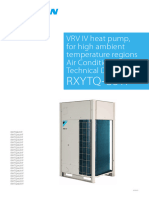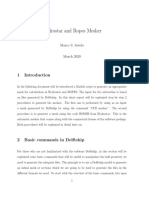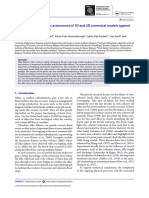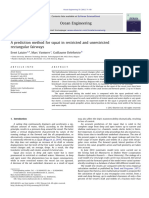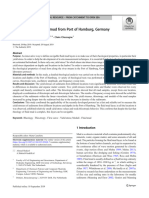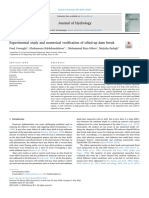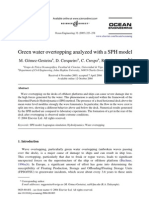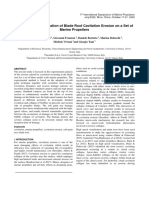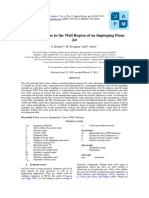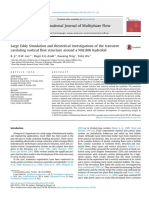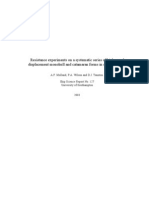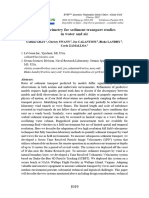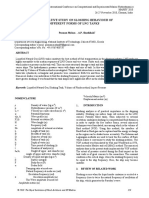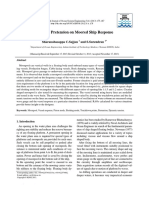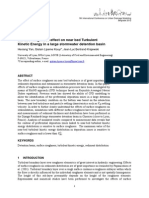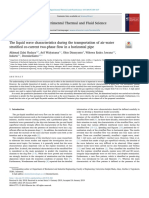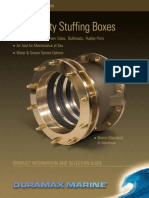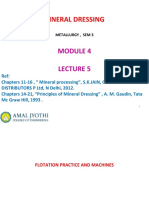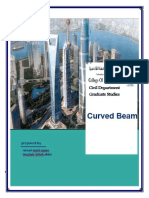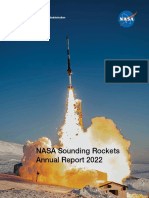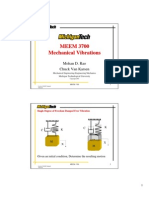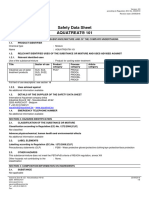0 ratings0% found this document useful (0 votes)
9 viewsInterCOH2021 Abstract MSotelo
InterCOH2021 Abstract MSotelo
Uploaded by
Marco SoteloThis document discusses an experimental and numerical study of a cylinder passing through a layer of fluidized natural mud. The study aims to better understand the behavior of ships sailing in real mud environments. Extensive experiments are being conducted to measure the hydrodynamic reactions on a cylinder towed through a channel filled with natural mud at different velocities and distances from the bottom. Computational fluid dynamics simulations are also being performed using a numerical model that accounts for the thixotropic behavior of natural mud. The preliminary results will provide insight into the phenomena and validate the numerical model by comparing to experimental data. The final conclusions will compare and discuss the outcomes of the experimental and numerical analyses.
Copyright:
© All Rights Reserved
Available Formats
Download as PDF, TXT or read online from Scribd
InterCOH2021 Abstract MSotelo
InterCOH2021 Abstract MSotelo
Uploaded by
Marco Sotelo0 ratings0% found this document useful (0 votes)
9 views1 pageThis document discusses an experimental and numerical study of a cylinder passing through a layer of fluidized natural mud. The study aims to better understand the behavior of ships sailing in real mud environments. Extensive experiments are being conducted to measure the hydrodynamic reactions on a cylinder towed through a channel filled with natural mud at different velocities and distances from the bottom. Computational fluid dynamics simulations are also being performed using a numerical model that accounts for the thixotropic behavior of natural mud. The preliminary results will provide insight into the phenomena and validate the numerical model by comparing to experimental data. The final conclusions will compare and discuss the outcomes of the experimental and numerical analyses.
Original Title
InterCOH2021_abstract_MSotelo
Copyright
© © All Rights Reserved
Available Formats
PDF, TXT or read online from Scribd
Share this document
Did you find this document useful?
Is this content inappropriate?
This document discusses an experimental and numerical study of a cylinder passing through a layer of fluidized natural mud. The study aims to better understand the behavior of ships sailing in real mud environments. Extensive experiments are being conducted to measure the hydrodynamic reactions on a cylinder towed through a channel filled with natural mud at different velocities and distances from the bottom. Computational fluid dynamics simulations are also being performed using a numerical model that accounts for the thixotropic behavior of natural mud. The preliminary results will provide insight into the phenomena and validate the numerical model by comparing to experimental data. The final conclusions will compare and discuss the outcomes of the experimental and numerical analyses.
Copyright:
© All Rights Reserved
Available Formats
Download as PDF, TXT or read online from Scribd
Download as pdf or txt
0 ratings0% found this document useful (0 votes)
9 views1 pageInterCOH2021 Abstract MSotelo
InterCOH2021 Abstract MSotelo
Uploaded by
Marco SoteloThis document discusses an experimental and numerical study of a cylinder passing through a layer of fluidized natural mud. The study aims to better understand the behavior of ships sailing in real mud environments. Extensive experiments are being conducted to measure the hydrodynamic reactions on a cylinder towed through a channel filled with natural mud at different velocities and distances from the bottom. Computational fluid dynamics simulations are also being performed using a numerical model that accounts for the thixotropic behavior of natural mud. The preliminary results will provide insight into the phenomena and validate the numerical model by comparing to experimental data. The final conclusions will compare and discuss the outcomes of the experimental and numerical analyses.
Copyright:
© All Rights Reserved
Available Formats
Download as PDF, TXT or read online from Scribd
Download as pdf or txt
You are on page 1of 1
Experimental and numerical study of a cylinder passing through fluidized
natural mud
Marco S. Sotelo1, Djahida Boucetta1, Bart Brouwers1,2 and Guillaume Delefortrie1,2
1
Maritime Technology Division, Ghent University, Ghent, Belgium E-mail: Marco.Sotelo@ugent.be
2
Department of Mobility and Public Works, Flanders Hydraulics Research, Antwerp, Belgium
1. Introduction study the overall behaviour of the system. The following
Navigation in shallow water over a thin layer of mud is a tests will be with natural mud.
common problem in many ports and waterways around
the world. Previous works demonstrated that sailing close 2.2 CFD simulations
or in contact with a mud layer changes drastically the Different analytical and numerical models have been
manoeuvrability of the vessels generally leading to a proposed to describe the thixotropic behaviour of natural
dangerous conditions (Delefortrie et al., 2007). However, mud and cohesive materials (Mewis & Wagner, 2009). In
due to the complex rheological behaviour of natural mud, this work, the updated numerical model proposed by
in many experimental and theoretical publications the Toorman (Toorman et al., 2014) is used to validate the
mud has been treated as a Newtonian fluid (Delefortrie & interphase interaction. The developed solver is
Vantorre, 2016; Doctors et al., 1996). To better implemented in the open source software OpenFOAM.
understand the behaviour of ships sailing in real mud
enviroments more research is required. The purpose of
this work is to study the behaviour of bluff bodies passing
through a layer of fluidized natural mud. As a first step,
extensive trials are conducted to predict the
hydrodynamic reactions on the body for different depth
and velocities. The resultant forces and moments are
recorded and accumulated as database. Additionally, Figure 1: Velocity field around a cylinder in the air-mud
CFD computations are performed using a newly inter-phase.
developed solver dedicated to specific cohesive material
applications (Toorman et al., 2014). The obtained 3. Conclusions
numerical results are compared to model tests and the The final conclusions and comparison of the experimental
overall outcome will give a better insight on the results will discussed in the final version of the paper.
phenomena.
References
2. Methodology Delefortrie, G., & Vantorre, M. (2016). Ship
The main scope of this work is the experimental study of manoeuvring behaviour in muddy navigation areas:
a cylinder passing through a layer of fluidized natural state of the art. Proceedings of the 4th International
mud. The test program is currently carried out at Flanders Conference on Ship Manoeuvring in Shallow and
Hydraulics Research with the support of the Research Confined Water with Special Focus on Ship Bottom
Foundation – Flanders (FWO). The test consists in towing Interaction, Hamburg, Germany
a cylinder of 200 mm diameter along a 560 mm wide Delefortrie, G., Vantorre, M., Verzhbitskaya, E., &
channel filled with natural mud, very similar to the work Seynaeve, K. (2007). Evaluation of safety of
presented by (Toorman et al., 2015). The cylinder will be navigation in muddy areas through real-time
towed at different velocities and distances from the maneuvering simulation. Journal of Waterway, Port,
bottom of the channel. With this tests it is expected to Coastal, and Ocean Engineering, 133(2), 125–135.
capture the reaction forces acting on the cylinder for Doctors, L., Zilman, G., & Miloh, T. (1996). Influence of
different conditions with natural mud. a bottom mud layer on the resistance of marine
vehicles. Ship Technology Research, 43(2), 51–61.
2.1 Experimental phase Mewis, J., & Wagner, N. J. (2009). Thixotropy. In
The experimental facilities consists in a channel of 18.5 Advances in Colloid and Interface Science (Vols. 147–
m long, 560 mm wide with a depth up to 560 mm. This 148, Issue C, pp. 214–227). Elsevier.
channel is equipped with 2 sets of for pressure sensors to Toorman, E., Liste, M., Heredian, M., Rocabado, I., &
monitor the pressure evolution in the fluid layers (water Vanlede, J. (2014). CFD Nautical Bottom- Rheology
and mud). Additionally, a set of 5 probes are installed to of fluid mud and its modeling (Issue WL Rapporten
monitor the pore pressure in the mud layer. Mud sampling 00_048).
will be performed after every run. The sample will be Toorman, E., Vandebeek, I., Liste Muñoz, M., Heredia,
characterized by a measurement protocol to monitor the M., Rocabado, I., Vanlede, J., Delefortrie, G.,
internal evolution of the mud layer. The object to be Vantorre, M., & Meersschaut, Y. (2015). Drag on an
towed will be a cylinder of 200 mm diameter. The object towed through a fluid mud layer: CFD versus
carriage is equipped with 3 load cells plus a torque sensor experiment. INTERCOH2015: 13th International
and 6 pressure sensors to record the reaction forces in the Conference on Cohesive Sediment Transport
cylinder throughout the tests. Due to the high blockage Processes. Leuven, Belgium, 7-11 September 2015,
ratio, the first series of tests will be with water only to 74(1997), 114–115.
You might also like
- Rxytq-U5yf Data BookDocument51 pagesRxytq-U5yf Data BookmohamedroyaleyeuaeNo ratings yet
- Stainless Steel SAE J405Document14 pagesStainless Steel SAE J405Radu BurloiuNo ratings yet
- Lecture 9 - Fate and Transport of PollutantsDocument33 pagesLecture 9 - Fate and Transport of PollutantsJoash SalamancaNo ratings yet
- Hydrostar and Ropes Mesher: Marco S. SoteloDocument5 pagesHydrostar and Ropes Mesher: Marco S. SoteloMarco SoteloNo ratings yet
- Moisture Influence On Structural Behavior of PavementsDocument79 pagesMoisture Influence On Structural Behavior of PavementsFrancis Ko Badongen-Cawi Tabaniag Jr.No ratings yet
- An Evaluation of The Osmotic Method of Controlling SuctionDocument24 pagesAn Evaluation of The Osmotic Method of Controlling SuctionSamuel Laura HuancaNo ratings yet
- JHR_2024_Breaching_exp_num1D2DDocument15 pagesJHR_2024_Breaching_exp_num1D2DdmenendezNo ratings yet
- Ocean Engineering: Evert Lataire, Marc Vantorre, Guillaume DelefortrieDocument10 pagesOcean Engineering: Evert Lataire, Marc Vantorre, Guillaume DelefortrieTausif RazzakNo ratings yet
- Resistance CommitteeDocument56 pagesResistance CommitteeTullio OpattiNo ratings yet
- Study of Passing Ship Effects Along A Bank by Delft3D-Flow and XbeachDocument10 pagesStudy of Passing Ship Effects Along A Bank by Delft3D-Flow and XbeachCarlosNo ratings yet
- Geotubes Proceeding CSt2011 FINAL PDFDocument13 pagesGeotubes Proceeding CSt2011 FINAL PDFathanasius_adiNo ratings yet
- A Test For Measuring Permeability of Geomembranes: January 2000Document11 pagesA Test For Measuring Permeability of Geomembranes: January 2000Manish Kumar SinghNo ratings yet
- Article RheologicalAnalysisOfMudFromPoDocument10 pagesArticle RheologicalAnalysisOfMudFromPoincemahirNo ratings yet
- Wave-Soil-Structure Interaction (WSSI) .Document9 pagesWave-Soil-Structure Interaction (WSSI) .Romoex R RockNo ratings yet
- Are View of Recent Research On Sand Dunes FormationDocument12 pagesAre View of Recent Research On Sand Dunes FormationJamyla LaouejNo ratings yet
- 1 s2.0 S0022169420307277 MainDocument17 pages1 s2.0 S0022169420307277 MainAvinash SajwanNo ratings yet
- Icst 2002Document6 pagesIcst 2002International Jpurnal Of Technical Research And ApplicationsNo ratings yet
- Gren Watervover ToppingDocument16 pagesGren Watervover ToppingSimon Achink LubisNo ratings yet
- Falling Head Permeability - 011Document8 pagesFalling Head Permeability - 011Bee-thumb FairusNo ratings yet
- Review A Review of The Multilevel Slug Test For Characterizing Aquifer HeterogeneityDocument13 pagesReview A Review of The Multilevel Slug Test For Characterizing Aquifer HeterogeneityMaria F. SarmientoNo ratings yet
- A Lifting Line Theory For A Three-Dimensional Hydrofoil: Hui Liang and Zhi ZongDocument7 pagesA Lifting Line Theory For A Three-Dimensional Hydrofoil: Hui Liang and Zhi ZongKoShweBaNo ratings yet
- THESISCVRDocument264 pagesTHESISCVRmariagraciavr18No ratings yet
- 1 s2.0 S0038080612001151 MainDocument16 pages1 s2.0 S0038080612001151 Mainnaomipurba32No ratings yet
- Flushing Study For Artificial Island: SciencedirectDocument8 pagesFlushing Study For Artificial Island: SciencedirectJeanOscorimaCelisNo ratings yet
- Open Channel Flow SimulationDocument15 pagesOpen Channel Flow SimulationAmritanshuSarangiNo ratings yet
- CFD Analysis of The Full-Scale Resistance of An Oil Tanker in Presence of A Mud-Water InterfaceDocument19 pagesCFD Analysis of The Full-Scale Resistance of An Oil Tanker in Presence of A Mud-Water InterfaceMahdiNo ratings yet
- Rug01-001418208 2010 0001 AcDocument149 pagesRug01-001418208 2010 0001 AcBrigitte Davila DelgadoNo ratings yet
- Experimental Study of Hydraulic Response of Smooth Submerged Breakwaters To Irregular WavesDocument15 pagesExperimental Study of Hydraulic Response of Smooth Submerged Breakwaters To Irregular WavesMABCHOUR HAMZANo ratings yet
- Bowthruster Induced DamageDocument181 pagesBowthruster Induced Damageyw_oulalaNo ratings yet
- 2004 - Christensen - Large Eddy Simulation of Spilling and Plunging BreakersDocument23 pages2004 - Christensen - Large Eddy Simulation of Spilling and Plunging BreakersLeizaNo ratings yet
- Yanuar 2012Document4 pagesYanuar 2012Steven Salazar ArangoNo ratings yet
- Root Cavitation 2-2-3Document8 pagesRoot Cavitation 2-2-3장영훈No ratings yet
- Archetti Oil SpillDocument4 pagesArchetti Oil SpillResniOktaviaNo ratings yet
- 1 s2.0 S0029801823011770 MainDocument17 pages1 s2.0 S0029801823011770 Main4si21cv008No ratings yet
- O A T A O Oatao: To Link To This Article: DOI:10.1017/jfm.2012.288Document40 pagesO A T A O Oatao: To Link To This Article: DOI:10.1017/jfm.2012.288kunal sinhaNo ratings yet
- Analysis of Offshore Jacket PlatformDocument8 pagesAnalysis of Offshore Jacket PlatformMuralidhar YarakalaNo ratings yet
- 3-D Numerical Model For Wave-Seabed Interactions Around Mono-Pile (2015)Document54 pages3-D Numerical Model For Wave-Seabed Interactions Around Mono-Pile (2015)RIOS TSENGNo ratings yet
- Comparative Study On Mooring Line Dynamic Loading - Brown & MavrakosDocument21 pagesComparative Study On Mooring Line Dynamic Loading - Brown & MavrakossojanvasudevanNo ratings yet
- Pak 2017Document15 pagesPak 2017Emanuel RicardoNo ratings yet
- Morphodynamic Modelling of Beach Cusp Formation - Xbeach - NhaTrangDocument47 pagesMorphodynamic Modelling of Beach Cusp Formation - Xbeach - NhaTrangluongnqNo ratings yet
- Field Experiments On Laterally Loaded Piles For An OffshoreDocument19 pagesField Experiments On Laterally Loaded Piles For An OffshoreSafia KhodaryNo ratings yet
- Vortex Structure in The Wall Region of An Impinging Plane JetDocument9 pagesVortex Structure in The Wall Region of An Impinging Plane JetRAVI KUMARNo ratings yet
- Extended Validation of Dynamic Design Formula For Scour Protection Around MonopilesDocument2 pagesExtended Validation of Dynamic Design Formula For Scour Protection Around MonopilesIssa DrdrNo ratings yet
- Ojs-Admin, 3Document16 pagesOjs-Admin, 3xylonNo ratings yet
- Waves PDFDocument61 pagesWaves PDFNicola CasoNo ratings yet
- Volume IIDocument246 pagesVolume IIathanasios niotisNo ratings yet
- 2020 STR - Experimental and Numerical Studies On Linear and Nonlinear Seakeeping Phenomena of The DTC Ship in Regular WavesDocument22 pages2020 STR - Experimental and Numerical Studies On Linear and Nonlinear Seakeeping Phenomena of The DTC Ship in Regular WavesFrank LiouNo ratings yet
- Wind Around CylinderDocument10 pagesWind Around CylinderAnonymous ARMtmNKLNo ratings yet
- Large Eddy Simulation and Theoretical Investigations of The Transient Cavitating Vortical Flow Structure Around A NACA66 HydrofoilDocument14 pagesLarge Eddy Simulation and Theoretical Investigations of The Transient Cavitating Vortical Flow Structure Around A NACA66 HydrofoilBrunoNo ratings yet
- 127ShipScience Report PDFDocument48 pages127ShipScience Report PDFTullio OpattiNo ratings yet
- 17 102 GrayDocument18 pages17 102 GrayBasem MohamedNo ratings yet
- MARHY18 S26 Poonam Mohan PDFDocument8 pagesMARHY18 S26 Poonam Mohan PDFPoonam MohanNo ratings yet
- 1 s2.0 S0009250910007190 MainDocument16 pages1 s2.0 S0009250910007190 Mainzhengguihua2020No ratings yet
- Effect of Pretension On Moored Ship RespDocument13 pagesEffect of Pretension On Moored Ship RespIvandito HerdayandityaNo ratings yet
- Sánchez 2011 - THM Analysis of A Large Scale Heating Test Incorporating Material FabricDocument31 pagesSánchez 2011 - THM Analysis of A Large Scale Heating Test Incorporating Material FabricBurak BulutNo ratings yet
- Session B.2 - 3.2Document21 pagesSession B.2 - 3.2sasa.vukojeNo ratings yet
- The Liquid Wave Characteristics During The Transportation of Air-Water Stratified Co-Current Two-Phase Flow in A Horizontal PipeDocument14 pagesThe Liquid Wave Characteristics During The Transportation of Air-Water Stratified Co-Current Two-Phase Flow in A Horizontal PipeMariana MezzariNo ratings yet
- P - Effect of Under Connected Plates On The Hydrodynamic Efficiency of The Floating Breakwater (2013)Document14 pagesP - Effect of Under Connected Plates On The Hydrodynamic Efficiency of The Floating Breakwater (2013)Ahmed BalahNo ratings yet
- The Influence of Partial Clogging and Pressure On The Behaviour of Geotextiles in Drainage SystemsDocument29 pagesThe Influence of Partial Clogging and Pressure On The Behaviour of Geotextiles in Drainage SystemsmarcosNo ratings yet
- 1 s2.0 S0169555X13001104 Main PDFDocument12 pages1 s2.0 S0169555X13001104 Main PDFvenno akbarNo ratings yet
- JH18 SoteloDocument12 pagesJH18 SoteloMarco SoteloNo ratings yet
- Instruments, Measurement Principles and Communication Technologies for Downhole Drilling EnvironmentsFrom EverandInstruments, Measurement Principles and Communication Technologies for Downhole Drilling EnvironmentsNo ratings yet
- Modelling Navigation in Muddy Areas Through Captive Model Tests (Delefortrie Et Al. 2005)Document15 pagesModelling Navigation in Muddy Areas Through Captive Model Tests (Delefortrie Et Al. 2005)Marco SoteloNo ratings yet
- 0102 Fluid Mud Properties in Nautical Depth Estimation (Mehta Et. Al 2014)Document13 pages0102 Fluid Mud Properties in Nautical Depth Estimation (Mehta Et. Al 2014)Marco SoteloNo ratings yet
- Hydrostar and Ropes Mesher: Marco S. SoteloDocument15 pagesHydrostar and Ropes Mesher: Marco S. SoteloMarco SoteloNo ratings yet
- Presaestopa-Johnson Stuffing BoxDocument32 pagesPresaestopa-Johnson Stuffing BoxMarco SoteloNo ratings yet
- Contaminarea Cu MelaninaDocument8 pagesContaminarea Cu Melaninadiana fenichiuNo ratings yet
- Nickel ElectroplatingDocument28 pagesNickel ElectroplatingRahul Pandey100% (2)
- Lecture5 Flotation Practice and MachinesDocument31 pagesLecture5 Flotation Practice and Machinesvince coNo ratings yet
- Class XII Chemistry Practical Record Vol2Document22 pagesClass XII Chemistry Practical Record Vol2yashrevasya2006No ratings yet
- Six Pillars of Organic Chemistry: (1) - The Objectives of The Six Pillar Approach Are (I) BuildingDocument5 pagesSix Pillars of Organic Chemistry: (1) - The Objectives of The Six Pillar Approach Are (I) BuildingVictor GuillénNo ratings yet
- Morison EquationDocument3 pagesMorison EquationChaidir TransmissionNo ratings yet
- Presentation SteelDocument40 pagesPresentation Steelprntech.nitjaaNo ratings yet
- ManufacturersDocument96 pagesManufacturersSilenceNo ratings yet
- Permeability PropertiesDocument12 pagesPermeability Propertieskiwi27_87No ratings yet
- Deterministic Transport TheoryDocument74 pagesDeterministic Transport TheoryDinkarNo ratings yet
- Automatic Slip RegulatorDocument4 pagesAutomatic Slip RegulatorRajesh ThulluriNo ratings yet
- Medical Gases Pipeline SystemDocument22 pagesMedical Gases Pipeline SystemRajath Kumar K R KNo ratings yet
- Journal of Food Engineering: Sarina Sulaiman, A.R. Abdul Aziz, Mohamed Kheireddine ArouaDocument7 pagesJournal of Food Engineering: Sarina Sulaiman, A.R. Abdul Aziz, Mohamed Kheireddine ArouaJonnah Faye MojaresNo ratings yet
- Curved BeamsDocument27 pagesCurved Beamshussain adelNo ratings yet
- Electrostatic Potential and Capacitance - Practice Sheet - VIJETA SERIES CLASS-12THDocument7 pagesElectrostatic Potential and Capacitance - Practice Sheet - VIJETA SERIES CLASS-12THjhalakmaroria28No ratings yet
- Annual Report 2022 - WebDocument72 pagesAnnual Report 2022 - WebRamón Omar Córdova MuñozNo ratings yet
- Outline of Lecture 9: Structural DynamicsDocument68 pagesOutline of Lecture 9: Structural DynamicslotushNo ratings yet
- Stage 8 - Worksheets - Chapter 4Document7 pagesStage 8 - Worksheets - Chapter 4poulomiNo ratings yet
- CO2 Utilization For Methanol Production Part IDocument13 pagesCO2 Utilization For Methanol Production Part Iguigoal2010100% (1)
- Mech VibrationDocument14 pagesMech VibrationSquakx BescilNo ratings yet
- Aquatreat® 101Document6 pagesAquatreat® 101pacificoneassociatesNo ratings yet
- Hydrology and Climatology For BSC Forestry StudentsDocument83 pagesHydrology and Climatology For BSC Forestry StudentsMadan ThapaNo ratings yet
- Eco-Toxicological Assessment of Heavy Metals in The Freshwater Apple Snail (Pila Ovata) From Selected Markets in Benin Metropolis, NigeriaDocument6 pagesEco-Toxicological Assessment of Heavy Metals in The Freshwater Apple Snail (Pila Ovata) From Selected Markets in Benin Metropolis, Nigeriaoiseoje WangbojeNo ratings yet
- Chem Manual LabDocument121 pagesChem Manual LabelyseNo ratings yet
- Crude Oil Assay - Hibernia (From Chevron Site)Document3 pagesCrude Oil Assay - Hibernia (From Chevron Site)Imtinan MohsinNo ratings yet
- How Do Fireworks Work - A Pyrotechnics Chemist Explains The Science Behind The Brilliant Colors and SoundsDocument4 pagesHow Do Fireworks Work - A Pyrotechnics Chemist Explains The Science Behind The Brilliant Colors and SoundsLiar LiarNo ratings yet
- Chapter4 PDFDocument26 pagesChapter4 PDFvaibhav dahiwalkarNo ratings yet
